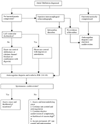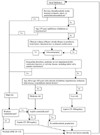Clinical review: clinical management of atrial fibrillation - rate control versus rhythm control
- PMID: 15312210
- PMCID: PMC522829
- DOI: 10.1186/cc2827
Clinical review: clinical management of atrial fibrillation - rate control versus rhythm control
Abstract
Atrial fibrillation (AF) is the most common sustained cardiac arrhythmia in the critically ill and is associated with adverse outcomes. Although there are plausible benefits from conversion and maintenance of sinus rhythm (the so-called 'rhythm-control' strategy), recent randomized trials have failed to demonstrate the superiority of this approach over the rate-control strategy. Regardless of approach, continuous therapeutic anticoagulation is crucial for stroke prevention. This review addresses the findings of these studies and their implications for clinical management of patients with atrial fibrillation.
Figures
Similar articles
-
Rate control versus rhythm control.Curr Opin Cardiol. 2005 Jan;20(1):15-20. Curr Opin Cardiol. 2005. PMID: 15596954 Review.
-
Rate vs rhythm control in patients with atrial fibrillation: a meta-analysis.Arch Intern Med. 2005 Feb 14;165(3):258-62. doi: 10.1001/archinte.165.3.258. Arch Intern Med. 2005. PMID: 15710787 Review.
-
Rate versus rhythm control in patients with atrial fibrillation: what the trials really say.Drugs. 2005;65(12):1651-67. doi: 10.2165/00003495-200565120-00004. Drugs. 2005. PMID: 16060699 Review.
-
Atrial fibrillation: rhythm control offers no advantage over rate control for some, but not all.Med Hypotheses. 2007;69(1):206-8. doi: 10.1016/j.mehy.2006.07.050. Epub 2006 Sep 29. Med Hypotheses. 2007. PMID: 17011138
-
Atrial fibrillation: pharmacological therapy.Curr Probl Cardiol. 2011 Mar;36(3):87-120. doi: 10.1016/j.cpcardiol.2011.01.001. Curr Probl Cardiol. 2011. PMID: 21392636 Review.
Cited by
-
Initial treatment strategies in new-onset atrial fibrillation in critically ill burn patients.Int J Burns Trauma. 2022 Dec 15;12(6):251-260. eCollection 2022. Int J Burns Trauma. 2022. PMID: 36660265 Free PMC article.
-
Rhythm control and cardioversion.Heart. 2007 Jan;93(1):29-34. doi: 10.1136/hrt.2006.099879. Epub 2006 Sep 8. Heart. 2007. PMID: 16963490 Free PMC article. Review. No abstract available.
-
Management of atrial fibrillation.Vasc Health Risk Manag. 2007;3(1):109-16. Vasc Health Risk Manag. 2007. PMID: 17583181 Free PMC article. Review.
-
Atrial fibrillation: primary prevention, secondary prevention, and prevention of thromboembolic complications: part 1.Front Cardiovasc Med. 2023 Jun 15;10:1060030. doi: 10.3389/fcvm.2023.1060030. eCollection 2023. Front Cardiovasc Med. 2023. PMID: 37396596 Free PMC article. Review.
-
Atrial Fibrillation on Intensive Care Unit Admission Independently Increases the Risk of Weaning Failure in Nonheart Failure Mechanically Ventilated Patients in a Medical Intensive Care Unit: A Retrospective Case-Control Study.Medicine (Baltimore). 2016 May;95(20):e3744. doi: 10.1097/MD.0000000000003744. Medicine (Baltimore). 2016. PMID: 27196499 Free PMC article.
References
-
- Go AS, Hylek EM, Phillips KA, Chang Y, Henault LE, Selby JV, Singer DE. Prevalence of diagnosed atrial fibrillation in adults: national implications for rhythm management and stroke prevention: the Anticoagulation and Risk Factors in Atrial Fibrillation (ATRIA) Study. JAMA. 2001;285:2370–2375. doi: 10.1001/jama.285.18.2370. - DOI - PubMed
-
- Benjamin EJ, Wolf PA, D'Agostino RB, Silbershatz H, Kannel WB, Levy D. Impact of atrial fibrillation on the risk of death: the Framingham Heart Study. Circulation. 1998;98:946–952. - PubMed
-
- Goldman L. Supraventricular tachyarrhythmias in hospitalised adults after surgery: clinical correlates in patients over 40 years of age after major noncardiac surgery. Chest. 1978;73:450–454. - PubMed
-
- Lauer MS, Eagle KA, Buckley MJ, DeSanctis RW. Atrial fibrillation following coronary artery bypass surgery. Prog Cardiovasc Dis. 1989;31:367–378. - PubMed
Publication types
MeSH terms
Substances
LinkOut - more resources
Full Text Sources
Medical



